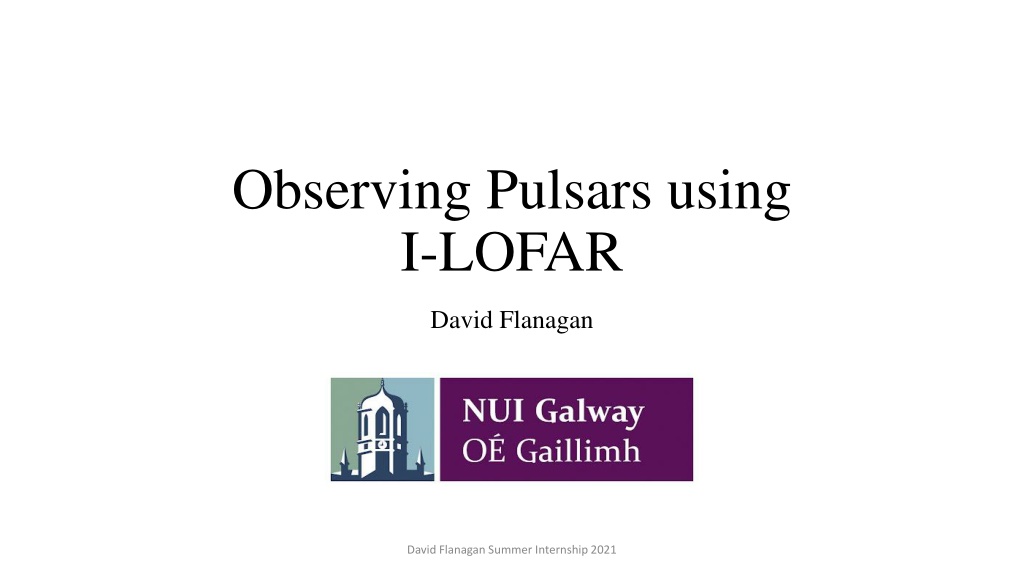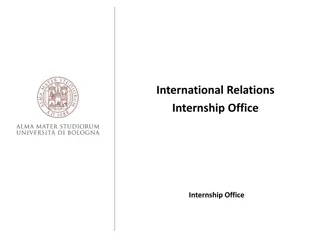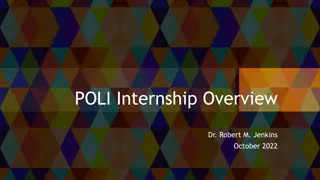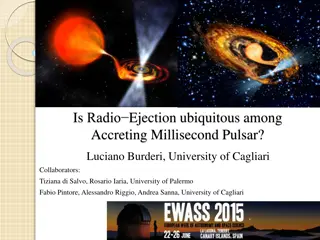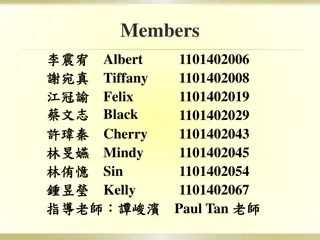Exploring Pulsars with I-LOFAR: David Flanagan Summer Internship 2021
Collapsed remnants of supernovae, pulsars emit electromagnetic radiation from their magnetic poles, observed using I-LOFAR at Birr Castle. Learn about Pulsar B1929+10, I-LOFAR operations, and accessing raw data during the research internship supervised by Dr. Aaron Golden.
Download Presentation

Please find below an Image/Link to download the presentation.
The content on the website is provided AS IS for your information and personal use only. It may not be sold, licensed, or shared on other websites without obtaining consent from the author. Download presentation by click this link. If you encounter any issues during the download, it is possible that the publisher has removed the file from their server.
E N D
Presentation Transcript
Observing Pulsars using I-LOFAR David Flanagan David Flanagan Summer Internship 2021
Acknowledgements This Research Internship was undertaken with supervision from Dr. Aaron Golden. A special word of thanks to Declan Bennett, D alta O Fionnag in and David McKenna. Finally, I d like to thank the School of Mathematics for allowing me to pursue this project. David Flanagan Summer Internship 2021
What are Pulsars? The collapsed remnants of supernova, pulsars are highly magnetized rotating compact stars. They emit beams of electromagnetic radiation out of their magnetic poles. Analogous to a lighthouse. At night, you only see the beam when it is pointing in your direction even though the light is constantly shining. Figure 1: Pulsar Animation David Flanagan Summer Internship 2021
I-LOFAR I-LOFAR located at Birr Castle in Co. Offaly is the Irish addition to the Low Frequency Array (LOFAR). LOFAR is an international network of state-of-the-art telescopes targeting low radio frequencies. Figure 2: Map of LOFAR telescopes David Flanagan Summer Internship 2021
How does I-LOFAR Operate At present, I-LOFAR operates as part of the European network five days a week while the remaining two are available to Irish astronomers to utilize. By day, I-LOFAR principally studies the Sun while by night celestial objects are observed. I-LOFAR consists of a network of antenna which collect data that is processed on servers located both on site and abroad. David Flanagan Summer Internship 2021
Observing PSR B1929+10 PSR B1929+10 is a well-known pulsar and could form the basis for studying long term pulse variations in these objects. Prior to observation, Dr. Golden requested observation time using I- LOFAR on our target pulsar. Target pulsar metrics from the Australian Telescope National Facility (ATNF) pulsar catalog will be used to process our data. On July 14th, 2021, I-LOFAR observed PSR B1929+10 for twenty minutes. David Flanagan Summer Internship 2021
Accessing Raw Data The REALtime Transient Acquisition cluster (R ALTA) is the main point to access and process data from I-LOFAR in near-realtime. R ALTA servers located in a (renovated) sheepshed next to I-LOFAR malfunctioned jeopordising our access to any data. Data accessed via an alternative method on Lugh server using a SSH client. David Flanagan Summer Internship 2021
Processing Raw Data First, a filterbank file converts raw pulsar-machine data to filterbank format: a stream of n- bit numbers corresponding to multiple polarization and/or frequency channels. For this project, a program written by pulsar astronomers, PRESTO was utilized in docker containers. Figure 3: Initial output from readfile command David Flanagan Summer Internship 2021
Radio Frequency Interference (RFI) Random noise signals from cars, homes, kettles, microwaves, mobiles show up as bursts or continual emission when observations occur. It is important to identify them and in turn mask them. To accomplish this, we call the rfifind command on our data. This command produces a recommended mask to apply to the data. David Flanagan Summer Internship 2021
Figure 4: Recommended RFI mask David Flanagan Summer Internship 2021
Fourier Transform A fourier transform of the data is conducted in order to produce a power spectrum of the data and minimize the environmental noise. Frequency of ~2Hz particularly stands out. Pulsar light curves tend to be quite sharp. This means from a fourier perspective, deconstructing a sharp peak results in harmonics. Harmonics come in multiples of some basic frequency. Therefore, from the ATNF catalog, our target pulsar frequency is ~4Hz and so the 2Hz peak is a multiple of the anticipated frequency. David Flanagan Summer Internship 2021
Peak at ~2Hz Click to add text Figure 5: Normalized Power Spectrum David Flanagan Summer Internship 2021
Prepfold The next step is to "fold our data" to obtain a clear pulsar signal. Since we have established values for the period and DM from ATNF we add these properties as arguments to the prepfold command. Produces a clear pulse. Figure 6: Prepfold visualisation David Flanagan Summer Internship 2021
Figure 7: Pulsar Postcard Plot David Flanagan Summer Internship 2021
Figure 7: Pulsar Postcard Plot David Flanagan Summer Internship 2021
Figure 7: Pulsar Postcard Plot David Flanagan Summer Internship 2021
Figure 7: Pulsar Postcard Plot David Flanagan Summer Internship 2021
Figure 7: Pulsar Postcard Plot David Flanagan Summer Internship 2021
Conclusions Pulsars are both fascinating and bizarre astronomical objects. I-LOFAR is capable of observing such objects. PRESTO is a versatile and powerful tool in analysing pulsar data. Always have a contingency plan for accessing your data! David Flanagan Summer Internship 2021
